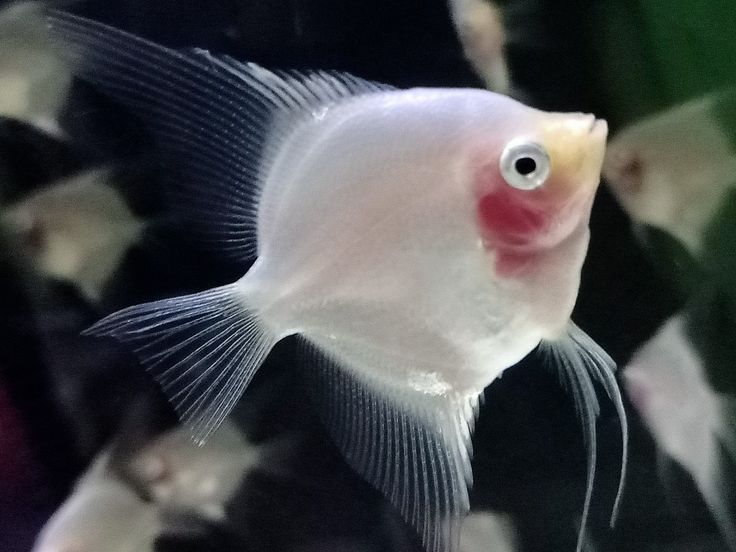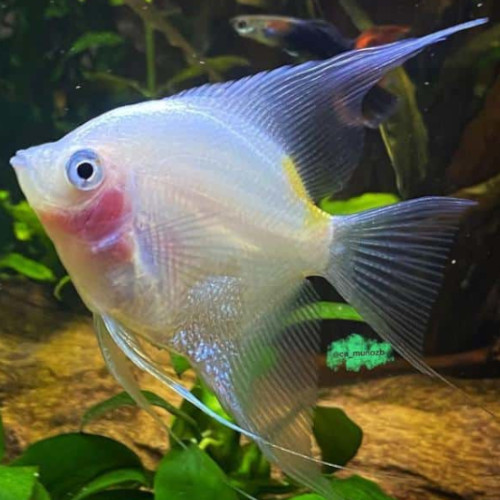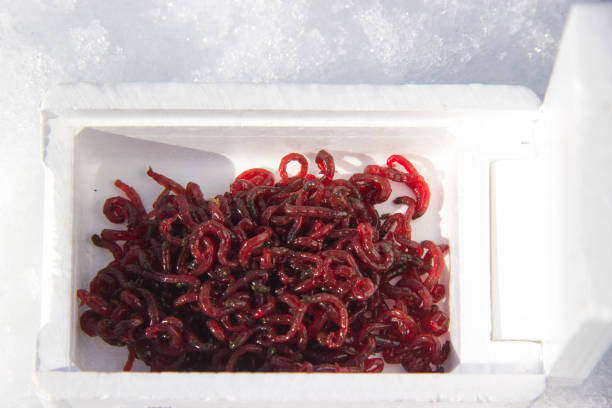The Angelfish are one of the most common and most recognized freshwater fish in the aquarium hobby. It’s almost impossible to find a freshwater aquarium without one of these beautiful cichlids swimming majestically and calling all the attention. They are often bred in different varieties; the most common ones are the graceful veil angelfish, koi angelfish, zebra angelfish and we cannot forget the stunning blushing angelfish.

Unveiling the Blushing Angelfish
The Exquisite Blushing Angelfish is a centerpiece fish in any aquarium; typically, tanks are built around this gorgeous freshwater cichlid. This pink-hued fish is slightly different from the other angelfish in coloration.
They are normally pale, with no pigmentation but a reddish/pinkish blush around their gills. This feature makes them stand out from every other freshwater fish in the hobby, making them one of the most sought-after species.
Much like other cichlids, this rare aquarium fish comes with its quirks and perks. Some say they can be a little tough to manage, especially for beginners, but I believe that with the proper guidance and tips, caring for this freshwater beauty is more rewarding than difficult.
I’ve provided this article as an overview of this striking angelfish variety, highlighting their care requirements and behaviors to help you successfully care for this unique fish.
Origins and Development
Angelfish, scientifically called Pterophyllum, are native to the warm and calm waters of the Amazon Basin in Peru, Colombia and Brazil. These species of freshwater cichlids were originally introduced in 1911 and since then have held a unique position in the fish-keeping world.
Often referred to as “Angels”, the wild Ptherophyllum cichlids live in smaller rivers and streams connected to the Amazon River. Their environment is often filled with algae and plants, and this beautiful variety has developed a body structure ideal for navigating their natural habitat without getting entangled in vegetation.
Blushing Angelfish’s lineage can be linked to the genus Pterophyllum scalare. Other members of this genus include Pterophyllum atum (Altum angelfish) and Pterophyllum leopoldi (dwarf angelfish).
Angelfish have been in captivity for a long time, and most variants stem from selective fish breeding. However, this rare angelfish’s development differs from others which explains their unique genetic features.
One of these unique traits is the “Stripeless” gene they possess. This gene represents the translucency displayed around the gills, resulting in the red or pink blush that earns it its name. Learning the fish’s breeding history gives you more insight into the level of care needed to maintain the physical features that keep them elegant.
Mesmerizing Physical Traits

The popularity of the Angelfish in the market has led to the selective breeding of many varieties, including the Blushing Angelfish. In the wild, these species have silver coloration with dark stripes;
thanks to breeding experimentation, you can find several other varieties like the Gold, Marble, Black and Pale varieties. The blushing angelfish features set it apart from the others, primarily because of the tint on its upper body, which is a different color from the rest of its body.
These pink-blush fish have large, elongated fins that flow beautifully when they swim, and their dorsal and anal fins stand vertically upright. One of the most exquisite features of this elegant finned fish is its fan-shaped caudal fin. Their tail fin is oriented vertically and long, adding to their graceful appearance when they move through the water.
They look diamond-shaped with a round and laterally compressed body. Their most unique feature is the “blushing” around their gills, which is caused by their red oxygenated blood showing through their gills.
Their distinctive fish pattern is well-suited for their vegetation-filled natural environment. Their medium size is another feature that adds to the angelfish’s allure, typically reaching a length of 6 inches and a height of about 9 inches or more.
Essential Care Guidelines for Blushing Angelfish
Your Blushing Angelfish’s upkeep may require your time, effort and money. This sacrifice is vital to keep them happy and maintain their vibrancy. Paying extra care to your pet’s environment is important in preserving the fish’s color. You must pay attention to the cleanliness and quality of your aquarium’s water.
You must maintain pristine water care practices like changing their water at least twice a week and maintaining strict water parameters. The pH of the water must be kept at 6.0 – 7.4 and hardness, 5.013dGH.
If you want to maintain optimal fish health, you should assess the water quality regularly using a liquid test kit like the one above. The importance of keeping the water and tank clean cannot be over-emphasized. This is important to maintain their vibrancy and ensure they live a long, healthy life.
Creating the Perfect Tank for Blushing Angelfish

One of the key things to note about the ideal Blushing Angelfish tank is to ensure it is closely similar to their original habitat. When setting up a home for your Blushing Angelfish, there are several parameters you need to factor in. These are:
Ideal Tank Size
When choosing the ideal tank for your blushing angelfish, you need to consider their fully grown size.
You need a tank that allows them to achieve their full size and height when they are mature and also provides more than enough space for them to swim around and establish territories.
Due to their height and vertical fins, the minimum size of tank you should consider should be 30 gallons. If you are planning to keep more than one fish, your tank should be larger.
Plants and Decoration
Because of the heavy vegetation in their natural environment, it is important to include plants in their tank. This can be a way of enhancing their tank’s aesthetics while allowing them to explore their environment, hide and ambush prey.
These plants are also important when breeding or laying eggs. You can consider aquarium plants like crypts, amazon swords, anubias and vallisneria aquarium plants. You can also substitute live plants for artificial plants.
Fish-friendly décor like driftwood could also be a useful ornament for your aquarium. The wood release substances that soften the water and provide shelter and hiding spots.
Heating and Filtration
A significant part of creating a tailored aquatic environment is the water quality and parameters. These fish prefer tropical, warm water temperatures ranging between 24 – 29°C.
To maintain this temperature, an aquarium heater should be installed to not only keep the water warm but also stabilize the water temperature. An aquarium filter should also be installed to remove the toxic waste products from the tank and keep it clean.
Nutritional Needs and Feeding Tips

Angelfish are omnivorous species and survive on both plant and animal-based diets. The most important aspect of the Blushing Angelfish nutrition is creating a balance between the fiber and protein content of their diet.
When creating a specialized fish diet, think about their natural feeding habit. In the wild, their food consists of up to 80% of fiber, and this needs to be accounted for in their meals.
Premium fish nutrition must contain vitamins, minerals, and other nutrients that keep them active. Here are some food options for your Blushing Angelfish.
· Flake Foods: Flakes are a cost-effective fish food option for your angelfish. Choose flake feeds specific for angelfish because they have the right proportion of nutrients.
· Frozen Foods: You can feed them frozen bloodworms, shrimp, or brine shrimp. These can serve as alternatives to live foods.
· Live Food: Live meals contain a lot of nutrients. They help your pet grow fast and improve their ability to reproduce. They also allow your friend to search for their meals and explore the tank.
For more on feeding your aquatic pets check out The Ultimate Guide to Fish Food: Pros and Cons & Best Choices!

According to the majority of aquarists, one of the best feeding practices for angelfish is to feed your pet as much food as they can consume in 60 seconds. It’s important not to leave them consuming food for extended periods of time.
Instead, you can extend your feeding periods by 20 seconds if they still seem hungry after the usual feeding period. Maintaining a strict feeding schedule is important so you don’t overfeed your pet.
Health and Wellness: Common Issues and Prevention
With freshwater fish, there’s no guarantee that your pet will remain disease-free. Most health problems and diseases can be avoided by proper tank maintenance and the provision of suitable tank mates.
However, some situations beyond your control may leave your pet susceptible to disease. Blushing Angelfish healthcare mainly involves learning how to prevent, recognize and treat these diseases. Some of the most common fish diseases includes parasites (ich), fish lice, dropsy and velvet disease.
Most fish illnesses can be traced to stress on the fish and weakened immune systems; the occurrence of this disease may be less in disease-resistant fish because their immune systems are much stronger.
In the case of the blushing angelfish, which may be susceptible to these diseases, proactive fish wellness schemes are required. This often involves some angelfish vitality tips like tracing the source of the stress or illness, adjusting the tank light to improve their immunity, performing partial water changes regularly and feeding your pet a highly nutritious diet.
A key part of aquatic disease prevention is quarantining newer additions to reduce their stress level and eliminate the possibility of any disease before including them in the community aquarium.
Successful Breeding of Blushing Angelfish
Breeding blushing angelfish is not a difficult task; however, breeding successfully is where the work is. Between mating the breeding pairs and hatching of the fry, several problems may occur and one of the most common problems with breeding is fungus and stress among the breeding pairs.
Selecting breeding pairs is the first step to successful angelfish breeding. Enhancing frying coloration begins with picking fish varieties with vibrant colors and majestic fins.
This video has been very helpful in identifying the sex of angelfish, I highly recommend it:
The second step to premium angelfish breeding is setting up a breeding tank, which should ideally be 55 to 75 gallons; but you can go as large as 90 gallons. Larger tank volumes are safer because it stays clean and free of toxic waste for a long time.
Separate the breeding pairs in the breeding tank and ensure optimal water parameters are maintained. Angelfish are known for their elaborate courtship behaviors which include fin-flaring and body tilting.
Once they mate, they become very involved in their offspring survival. Often the guard and fan their eggs to ensure proper circulation. Successful fish spawning can be guaranteed by separating the fish fry from the parents to ensure they don’t get eaten.
Blushing Angelfish are generally calm and peaceful freshwater fish. They are good tank mates.
Blushing angelfish’s temperament is known to be calm and peaceful. However, fully grown angelfish are known to get aggressive towards each other, especially when protecting their breeding pair.
They also feed on smaller fish and anything that can fit into their mouths. These behavioral characteristics are important factors to consider when choosing compatible tank mates for your pet. Because of their peaceful temperament, they often pair well with medium-sized catfish, peaceful barbs, rainbow fish and corydoras.
If you plan to own a community tank, the harmonious aquarium dynamics of the blushing angelfish make it easy to keep multiple varieties of fish in the same tank. These species are lively and intelligent creatures; their social fish behavior adds to their allure and commands all the attention in the room.
To ensure peaceful aquatic interactions, it’s essential to pair your angelfish with non-aggressive, medium-sized fish that match their personality and temperament.
Conclusion
A proper blushing angelfish care recap won’t be complete without emphasizing the importance of maintaining a clean tank and optimal water parameters for your pet. Some of the most important aquarium excellence tips to prioritize include providing a highly nutritious diet for your hatched fry and grown angelfish and avoiding overcrowding of their tanks.
The care tips offered in this angelfish care guide should be exercised in your maintenance routine and care practice. These tips are important for enhancing your fish’s beauty and ensuring they are strong and agile.
With these care tips I have provided for you, I can guarantee that your angelfish journey will be rewarding.



